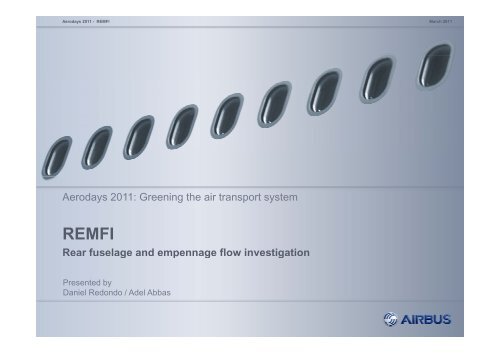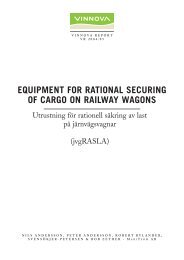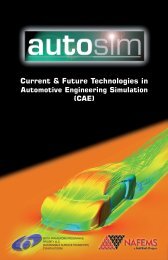Aerodays 2011 - Transport Research & Innovation Portal
Aerodays 2011 - Transport Research & Innovation Portal
Aerodays 2011 - Transport Research & Innovation Portal
You also want an ePaper? Increase the reach of your titles
YUMPU automatically turns print PDFs into web optimized ePapers that Google loves.
<strong>Aerodays</strong> <strong>2011</strong> - REMFI<br />
March <strong>2011</strong><br />
<strong>Aerodays</strong> <strong>2011</strong>: Greening the air transport system<br />
REMFI<br />
Rear fuselage and empennage flow investigation<br />
Presented by<br />
Daniel Redondo / Adel Abbas
<strong>Aerodays</strong> <strong>2011</strong> - REMFI<br />
March <strong>2011</strong><br />
REMFI - 6th Framework Programme - Partners<br />
Rear Fuselage and Empennage<br />
Flow Investigation<br />
© AIRBUS Operations S.L. All rights reserved. Confidential and proprietary document.
<strong>Aerodays</strong> <strong>2011</strong> - REMFI<br />
March <strong>2011</strong><br />
REMFI: Main goals<br />
Improved<br />
computational<br />
predictions for<br />
fuselage and tail<br />
design and<br />
analysis.<br />
Enhanced<br />
understanding<br />
of the flow<br />
physics around<br />
the tails and<br />
rear end.<br />
Improved<br />
experimental<br />
capabilities and<br />
measuring<br />
techniques for tail<br />
flows.<br />
WP1<br />
Project management and coordination<br />
WP2<br />
Empennage improved control surface efficiency<br />
i<br />
WP3<br />
WP4<br />
WP5<br />
Sting mounting arrangement investigation<br />
Experimental verification study<br />
Innovative fuselage and empennage designs<br />
© AIRBUS Operations S.L. All rights reserved. Confidential and proprietary document.
<strong>Aerodays</strong> <strong>2011</strong> - REMFI<br />
WP2<br />
Empennage improved control surfaces efficiency<br />
March <strong>2011</strong><br />
Prediction of<br />
gap effects<br />
• Highly time consuming.<br />
• Tendencies (Re, M, gap) well predicted (similar<br />
deltas values compared with WTT)<br />
• The better aero solution is always the gap sealed<br />
one.<br />
• Gaps geometry need to be perfectly represented<br />
(aircraft deformation needed)<br />
• Reynolds effects on gaps are important.<br />
FUSELAGE/ELEVATOR GAP<br />
Sealed/Unsealed<br />
SHROUD GAP<br />
Always closed<br />
Elevator/rudder<br />
efficiency<br />
• Small transition influence. Mach-dependence d more<br />
pronounced.<br />
• Important influence of Reynolds number on results<br />
(till 15%)<br />
• Good comparison between WT and CFD results in<br />
linear range. Better comparison at higher Re.<br />
© AIRBUS Operations S.L. All rights reserved. Confidential and proprietary document.
<strong>Aerodays</strong> <strong>2011</strong> - REMFI<br />
WP2<br />
Empennage improved control surfaces efficiency<br />
March <strong>2011</strong><br />
Scaling<br />
methodology:<br />
Re effect<br />
• CFD, WTT & SEM approach comparison<br />
• Pseudo Reynolds effects indentified & studied: twin sting<br />
boom<br />
• Cp good agreement<br />
• Absolute drag not matched. Tendencies with better<br />
matching.<br />
• Scaling methodology by scaling viscous drag and pressure<br />
drag separately<br />
RANS<br />
URANS<br />
DES<br />
Tail stall<br />
• Improvements limited to delta effects<br />
• Earlier stall with negative elevator deflection<br />
Mach=0.20, AoA=-22º, Re=38M, Fully turbulent<br />
• Lift increased and drag reduced at high Re<br />
• Stall delayed and lift enhanced with sealed fuselage gap<br />
(small influence)<br />
•Early transition enhances lift and delays separation<br />
• Small turbulence model influence, especially at high Re<br />
• RANS mean values are consistent up to the stall<br />
• Time accurate solutions necessary for post-stall<br />
© AIRBUS Operations S.L. All rights reserved. Confidential and proprietary document.
<strong>Aerodays</strong> <strong>2011</strong> - REMFI<br />
WP3<br />
Sting mounting arrangement investigation<br />
March <strong>2011</strong><br />
Twin y)<br />
sting<br />
boom<br />
location<br />
effect<br />
• CFD capable of reproducing interference effects (RANS<br />
necessary)<br />
• Wing downwash modified<br />
• Shock induced separation and turbulence effects (strong Re<br />
dependency)<br />
• Strong disturbance of supersonic flow around wing<br />
• High sensitivity to TSR geometry and location (strongest at<br />
innermost position)<br />
• Combination of advantages of experimental and numerical<br />
approaches delivers enhanced insight<br />
Standard Split Gap<br />
Labyrinth-type Split Gap<br />
Split<br />
fuselage<br />
gap<br />
effect<br />
• Smooth dependence of drag, lift and moment coefficients with M,<br />
Re and angle of attack<br />
• Fuselage flow field and gap flow field are quasi-independent for<br />
situations without deflection<br />
• Insertion of deflection angle in the rear end generates a high<br />
crossflow through the gap, with major effect on the boundary layer.<br />
• Internal gap recirculation<br />
• Irrelevant effect of gap location<br />
• Relevant suction effect with gap width due to recirculation<br />
• Labyrinth gap reduces gap pressure correction<br />
© AIRBUS Operations S.L. All rights reserved. Confidential and proprietary document.
<strong>Aerodays</strong> <strong>2011</strong> - REMFI<br />
WP3<br />
Methods for<br />
measuring /<br />
predicting<br />
wing<br />
deformation<br />
on twin<br />
sting<br />
models<br />
Sting mounting arrangement investigation<br />
• SPT, ESPT and IPCT with very good<br />
agreement, but intrusive at high Re.<br />
• HTP deformation with very small influence<br />
• Rear balance deformation improves prediction<br />
accuracy<br />
• Main wing deformation with very small<br />
influence<br />
March <strong>2011</strong><br />
IPCT coating<br />
SPT marker on Wing & HTP<br />
© AIRBUS Operations S.L. All rights reserved. Confidential and proprietary document.
<strong>Aerodays</strong> <strong>2011</strong> - REMFI<br />
WP4<br />
Experimental verification study<br />
March <strong>2011</strong><br />
Full-size<br />
Reynolds<br />
number tests<br />
Moveable HTP<br />
HTP interface<br />
Twin sting<br />
Rear balance<br />
Classical<br />
wind tunnel<br />
tests<br />
© AIRBUS Operations S.L. All rights reserved. Confidential and proprietary document.
<strong>Aerodays</strong> <strong>2011</strong> - REMFI<br />
WP4<br />
Experimental verification study<br />
March <strong>2011</strong><br />
Moveable<br />
HTP<br />
• Remote control system for HTP motorization<br />
• Very high h loads<br />
• High accuracy: setting accuracy 0.1º,<br />
measuring accuracy 0.01º<br />
• Operation in cryogenic environment (-160º C)<br />
Remote Control System for HTP<br />
HTP<br />
interface<br />
• Pressure routing through complex HTP<br />
interface.<br />
• Contionuous sealing system for criogenic<br />
conditions.<br />
Motor<br />
Spring Loaded<br />
Support HTP Inclinometer<br />
Elevator/FuselageSealing<br />
Teflon/Spring Arrangement<br />
Sealing<br />
Lever Arm<br />
PSI Scanner<br />
Load Bridge<br />
(HTP Interface)<br />
REMFI RC-System.MPG<br />
HTP/RC System Interface with<br />
Tubeless Pressure Connection<br />
© AIRBUS Operations S.L. All rights reserved. Confidential and proprietary document.
<strong>Aerodays</strong> <strong>2011</strong> - REMFI<br />
WP4<br />
Experimental verification study<br />
March <strong>2011</strong><br />
Twin<br />
sting<br />
• New wing for cryogenic test and twin-sting boom<br />
adapters (3 for ARA, 1 for ETW)<br />
Rear<br />
balance<br />
• Rear fuselage incl. Live-rear-end split plane<br />
• Labyrinth sealing for fuselage split concept<br />
• Standard split gap (1.45 mm) enlarged split gap<br />
(2.25 mm) and labyrinth sealing.<br />
• Pressure measures for split plane<br />
Standard Split Gap<br />
Labyrinth-type Split Gap<br />
Fuselage split<br />
Labyrinth sealing<br />
© AIRBUS Operations S.L. All rights reserved. Confidential and proprietary document.
<strong>Aerodays</strong> <strong>2011</strong> - REMFI<br />
WP5<br />
Innovative fuselage and empennage<br />
March <strong>2011</strong><br />
Innovative<br />
complete<br />
fuselage and<br />
empennage<br />
design<br />
•Rear end length has shown optimum values with a lower fineness<br />
boundary<br />
•Integrated belly fairing design results in drag reduction<br />
•BF introduces a lift drop and drag increase with respect to<br />
fuselage-wing.<br />
•No major improvements by a tangent intersection of the fuselage<br />
and belly fairing in the rear part.<br />
•Integration with wing has the biggest potential for drag reduction.<br />
•Increased volume near wing LE & TE improves the area ruling, but<br />
the volume near front of wing reduces the distance BF-engine and<br />
is detrimental.<br />
•Onglets and fillets have been proven to reduce drag and delay<br />
separation.<br />
Prediction<br />
cabpabilities<br />
for thick<br />
boundary<br />
layer at rearend<br />
•Better lift prediction than drag prediction (understimated)<br />
•Different boundary layer models showed strong influence on the BL<br />
profile and thickness<br />
•Best solutions seem to be obtained with different BL models for<br />
drag evaluation or boundary layer thickness for intlet/outlet<br />
behaviour.<br />
•Turbulence models effect only onskin fi friction values<br />
•Parametric evolution can be predicted with calculation (a refference<br />
experimental case could be sufficient)<br />
© AIRBUS Operations S.L. All rights reserved. Confidential and proprietary document.
<strong>Aerodays</strong> <strong>2011</strong> - REMFI<br />
WP5<br />
Innovative fuselage and empennage<br />
March <strong>2011</strong><br />
Drag<br />
prediction<br />
and<br />
breakdown<br />
for fuselage<br />
and tail<br />
components g( )<br />
• Automatic adaptation needs reliable procedures<br />
• Grid is the main source of differences on drag<br />
among the CFD code solutions<br />
• Near field methods show good agreement among<br />
different CFD codes.<br />
• Drag breakdown<br />
• Wave drag (FF)<br />
• Refined grid necessary along the chord at the shock<br />
(size/chord 0.5%)<br />
• Adaptative meshing useful to reduce the number of<br />
cells.<br />
• Induced d drag (NF and FF)<br />
• Small influence of mesh size at the tip<br />
• Friction or viscous drag (NF and FF)<br />
• Usual boundary layer mesh desnsity is not enough.<br />
• Pressure drag (NF)<br />
• Refinement in the leading edge has an influence in<br />
spurious drag.<br />
• Small geometries drag<br />
• Onglet on HTP leads to drag reduction via pressure drag<br />
(NF) or induced drag (FF)<br />
• Antenna on fuselage leads to drag increase via<br />
pressure drag (NF) or induced drag (FF)<br />
Fine grid (x3)<br />
Coarse grid<br />
Contributing cells to wave drag<br />
© AIRBUS Operations S.L. All rights reserved. Confidential and proprietary document.
<strong>Aerodays</strong> <strong>2011</strong> - REMFI<br />
March <strong>2011</strong><br />
© AIRBUS Operations S.L. All rights reserved. Confidential and proprietary document. This document and all information contained herein is the sole property of AIRBUS Operations S.L. No intellectual property rights<br />
are granted by the delivery of this document or the disclosure of its content. This document shall not be reproduced or disclosed to a third party without the express written consent of AIRBUS Operations S.L. This document<br />
and its content shall not be used for any purpose other than that for which it is supplied. The statements made herein do not constitute an offer. They are based on the mentioned assumptions and are expressed in good<br />
faith. Where the supporting grounds for these statements are not shown, AIRBUS Operations S.L. will be pleased to explain the basis thereof.<br />
AIRBUS, its logo, A300, A310, A318, A319, A320, A321, A330, A340, A350, A380, A400M are registered trademarks.<br />
© AIRBUS Operations S.L. All rights reserved. Confidential and proprietary document.

















